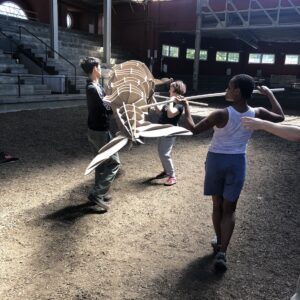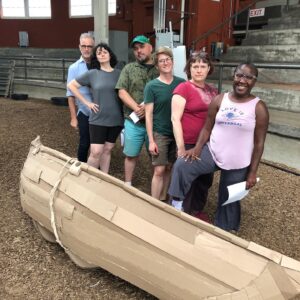URBANA -Deke Weaver’s The Unreliable Bestiary is a performance series about animals, their environments, and how humans interact with them. His life-long project has a performance for each letter of the alphabet and so far includes Monkey, Elephant, Wolf, Bear, and Tiger. Cetacean, represented by a whale, is the sixth installment of the project and runs Thursday, September 28th through Monday, October 2nd at the Stock Pavilion on the University of Illinois Campus in Urbana.
IPM Reporter, Owen Henderson, and Morning Edition Host, Kimberly Schofield, spoke with Deke Weaver and Jennifer Allen, the codirector and collaborator for Cetacean, about the inspiration and meaning behind this performance and the series as a whole.
Kimberly Schofield: Deke, can you start by telling us how you even came up with the idea The Unreliable Bestiary?

Deke Weaver: It started with some of the big Sierra Club, World Wildlife Federation…they’ll call them charismatic megafauna…so the big animals that are sort of the superstars of the zoos and cartoons. Starting with monkey, elephant, and then getting into all the complicated stuff around our relationships with the different kinds of animals, and the environment, and us, and economics. The animals end up kind of almost being like barkers at the door of the carnival tent. You get people in the tent, and you start spelling out all the different sorts of ways that we’re all interconnected and how a lot of those connections are starting to fray.
Owen Henderson: And Jennifer, how did you initially get brought in?
Jennifer Allen: We both do share a passion about the environment and the natural world. I grew up in Oregon. He grew up in Minnesota, I grew up in Oregon in the 70s, which I think was even like a further layering of environmentalism and awareness and caring about trees and the environment. And then when I moved to New York and lived in a really urban environment, I was introduced to a lot of people who really hadn’t had any experience with the outdoors and didn’t think of it as important in any way. And so that’s been a common passion of ours is giving voice to the voiceless.
OH: In the description of the Bear performance, you tied in -with the idea of the bear’s hibernation cycle- the story of Persephone from the Greek myth and the cycle of climate. I was curious how you came to weave that part into this performance…that might at the outside seem like a solely environmentally focused thing.
DW: I think what this show does a lot is juxtaposing facts about parts of the environment that are really having a hard time because of all kinds of different things. Things we take for granted like plastic and how when you make plastic, it’s made with forever chemicals. When they leach out of plastic that’s breaking down, it gets into life cycles. They’re endocrine disruptors. They really affect animal systems, human systems, our connections with animal systems…with life systems all around the world. And you just kind of take the plastic for granted. So you take these things that are starting to break the world down and you’re putting them up against stories where it’s just very simple and very stark. Stories about animals and people and water and the sun and just…the very simple sort of myths and putting those things up against each other. And I think there’s a kind of power there in that juxtaposition…that rubbing up against of those two different places.

KS: Breaking down the concerns about animals and humans and everything that’s going on in the world can seem like it could be kind of heavy. Is there any hope in this kind of man-versus-nature scenario?
JA: People face their shadow and their light daily. And there is always an equal balance. Even though it seems like things are dark now, the reality of nature is that it is always balanced.
DW: One thing that has just come up over the last year and a half, which is really interesting is that there are four different mechanisms of whales and what they do in the ocean that make them kind of the single easiest way to kind of fight climate change. One of the things they do is…whale poo is very good for the plants, the phytoplankton, and phytoplankton is the biggest producer of oxygen, the sequestering of carbon, I think on the planet. I think 40% is produced by phytoplankton. And so the more whales there are, the more carbon is going to get sequestered. And so being able to understand how big whale populations are, and protect whale populations, is only going to help.

Krannert Center for the Performing Arts is an underwriter of Illinois Public Media.

